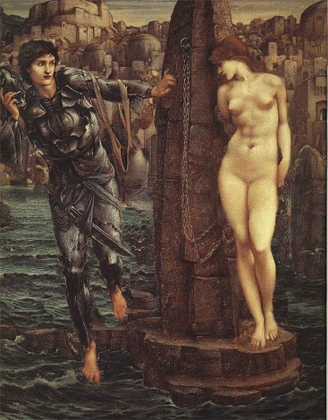'The Rock of Doom', by Sir Edward Coley Burne-Jones was painted between 1885 and 1887. This painting is the sixth in Burne-Jones' Perseus Cycle. This picture, like others in the series, draws upon the version of the Perseus legend that appears in William Morris's "The Doom of King Acrisius" from The Earthly Paradise. The picture is in some ways relevant to the issues previously discussed.  The theme of a helpless woman in peril being rescued by a heroic male is recurrent in the history of Western art (St. George and the Dragon for example). A Fruedian analysis of this work seems appropriate. The rock Andromeda is chained to is unquestionably phallic. The sea monster she is to be sacrificed to can be seen as another phallic symbol; a metaphor for the evil of unrestrained male sexuality. The viewer is invited to be a voyeur; Andromeda is naked and completely helpless. Perseus is clad in a complete suit of armour, also phallic in that it's rigidity holds his body in a state of permanent erection. This might seem a long bow to draw but the fact remains that the female is depicted as passive and helpless and the male active and heroic. Perseus face remains mysteriously androgenous. This is typical of males in Burne Jones' work.
The theme of a helpless woman in peril being rescued by a heroic male is recurrent in the history of Western art (St. George and the Dragon for example). A Fruedian analysis of this work seems appropriate. The rock Andromeda is chained to is unquestionably phallic. The sea monster she is to be sacrificed to can be seen as another phallic symbol; a metaphor for the evil of unrestrained male sexuality. The viewer is invited to be a voyeur; Andromeda is naked and completely helpless. Perseus is clad in a complete suit of armour, also phallic in that it's rigidity holds his body in a state of permanent erection. This might seem a long bow to draw but the fact remains that the female is depicted as passive and helpless and the male active and heroic. Perseus face remains mysteriously androgenous. This is typical of males in Burne Jones' work.
The idea of rescue was quite prevalent in 19th century society. Countless philanthropists established shelters for 'fallen women' to help set them on the path to 'virtue'. The underlying idea is that female sexuality is something that must be controlled. Despite the advances of more recent times women are still characterised as the 'weaker sex'.
This painting also characterises the stereo types of women that appear in Greek mythology. Women seldom if ever have any real personality. They are helpless victims like Andromeda, or are part beast predators like the mermaids, the sirens and the harpies. One only has to look at the classical design of law courts, places of government and other official buildings to realise that the Greek ideal is still alive today. This is not to say that the culture and art of the ancient Greeks (and Burne Jones) is anything but beautiful, but that their gender bias in many ways continues to permeate our lives.



No comments:
Post a Comment